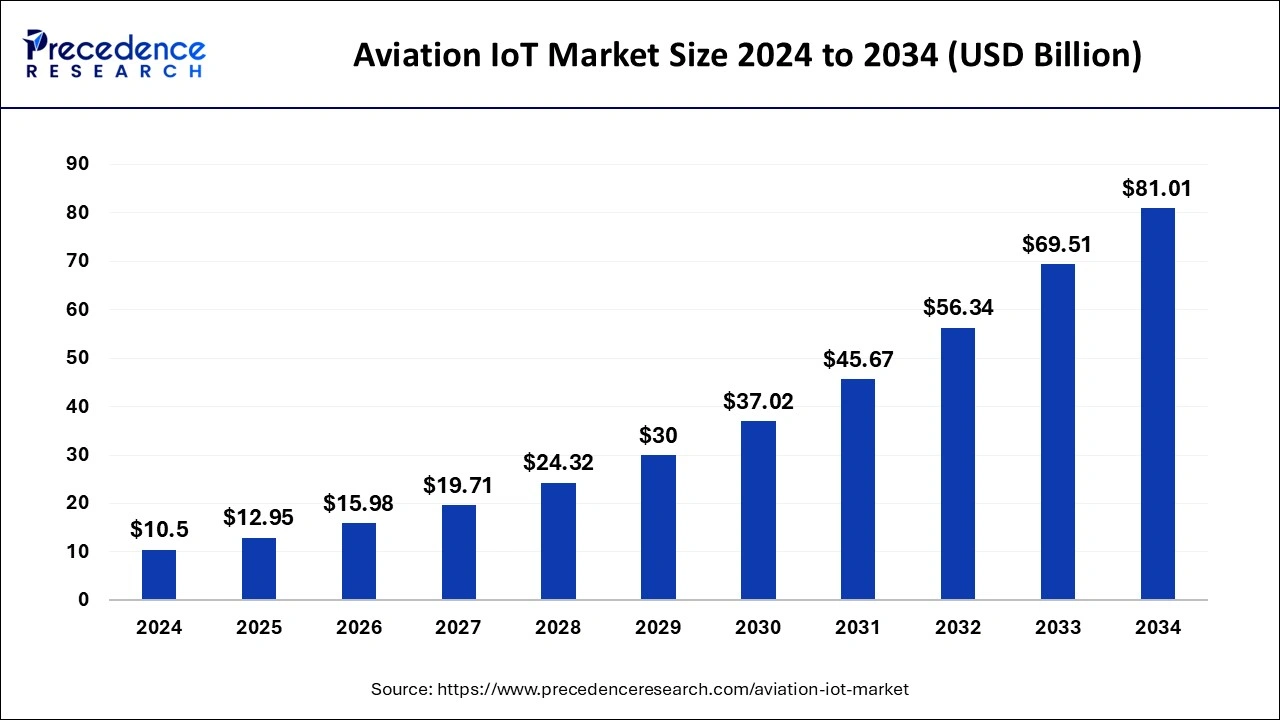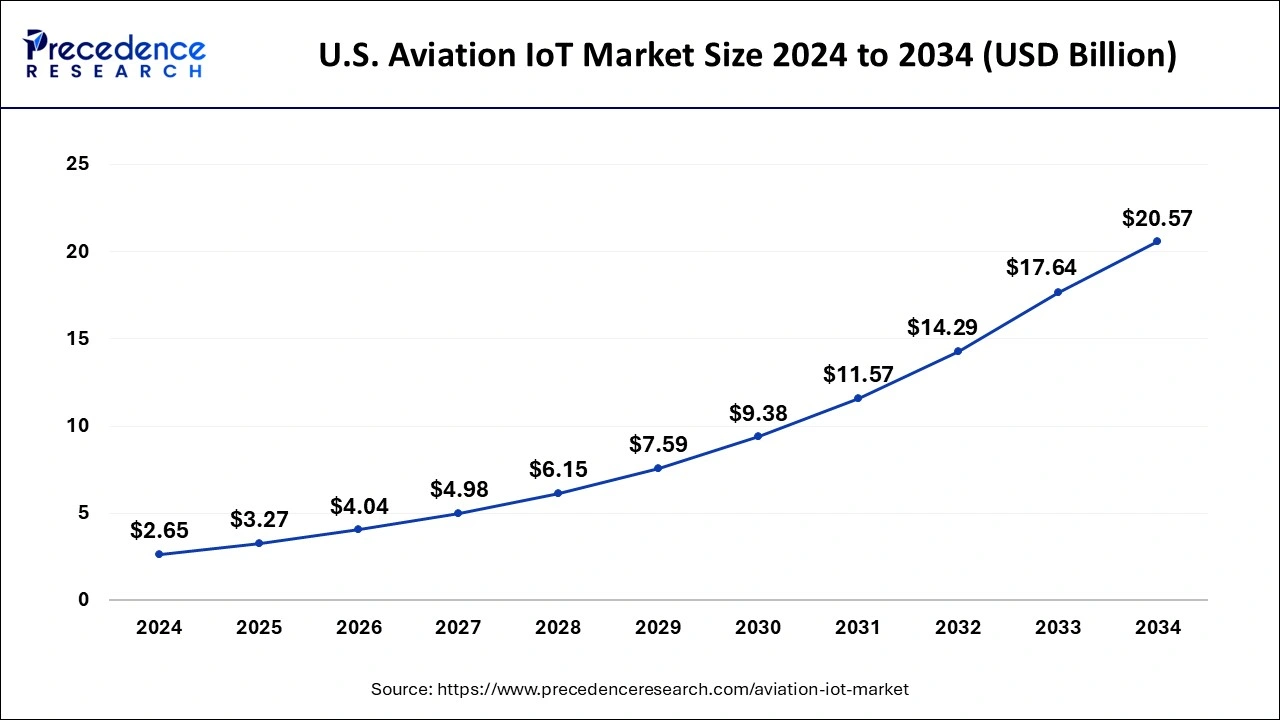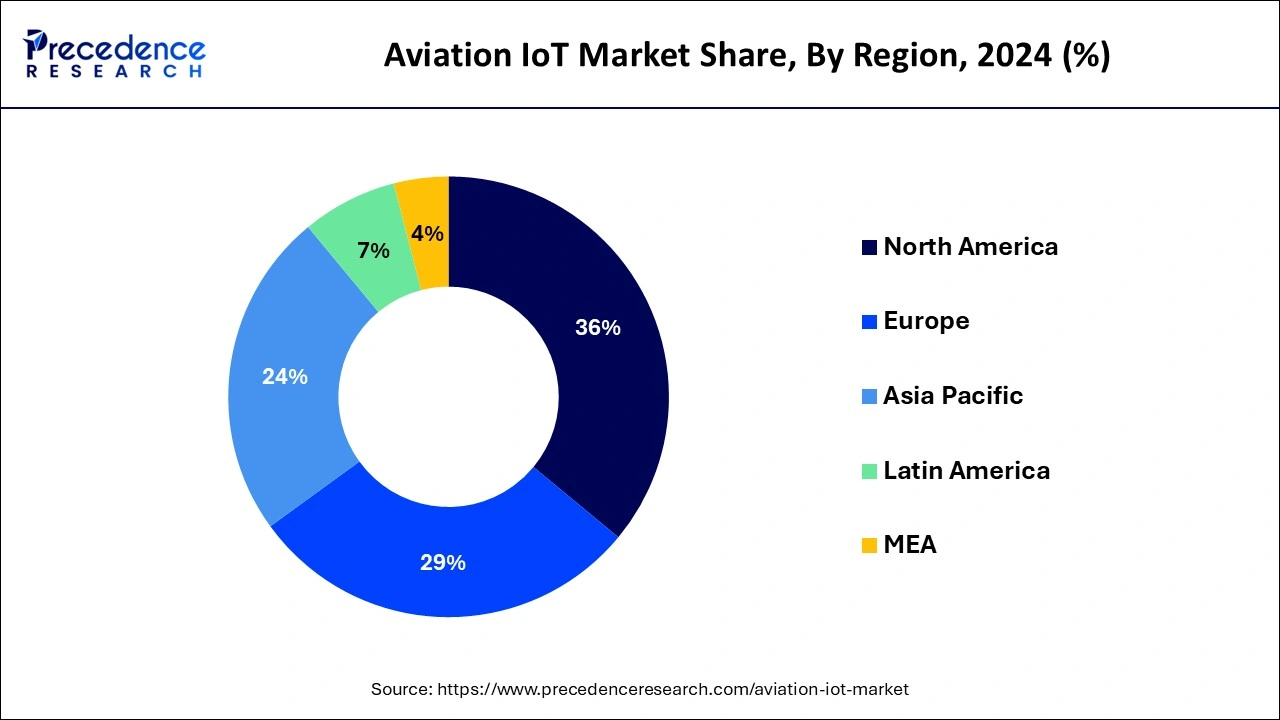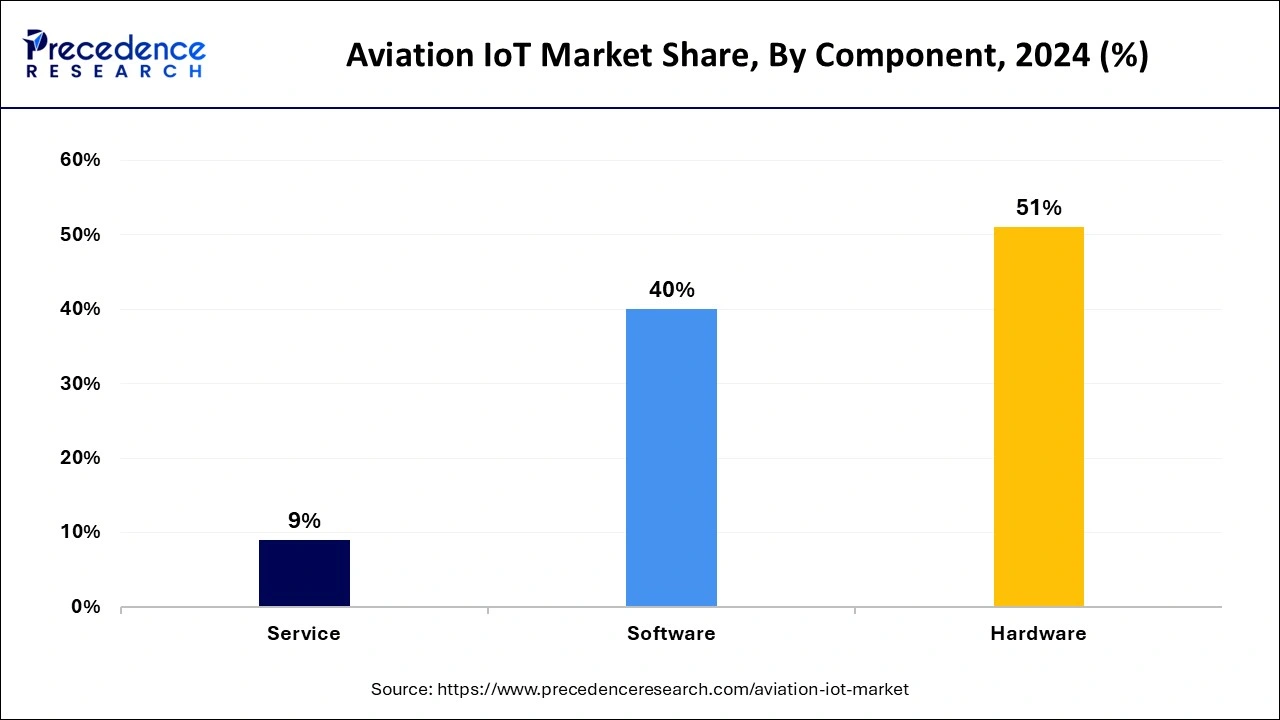November 2024
The global aviation IoT market size is calculated at USD 12.95 billion in 2025 and is forecasted to reach around USD 81.01 billion by 2034, accelerating at a CAGR of 22.67% from 2025 to 2034. The North America aviation IoT market size surpassed USD 3.78 billion in 2024 and is expanding at a CAGR of 22.70% during the forecast period. The market sizing and forecasts are revenue-based (USD Million/Billion), with 2024 as the base year.
The global aviation IoT market size was estimated at USD 10.50 billion in 2024 and is predicted to increase from USD 12.95 billion in 2025 to approximately USD 81.01 billion by 2034, expanding at a CAGR of 22.67% from 2025 to 2034. The growing trend of air travel with an emphasis on passenger experience is anticipated to drive market growth.

The U.S. aviation IoT market size reached USD 2.65 billion in 2024 and is projected to be worth around USD 20.57 billion by 2034, poised to grow at a CAGR of 22.74% from 2025 to 2034.

North America dominated the aviation IoT market securing the largest market share of 36% in 2024. This was primarily driven by the region's well-established aviation industry, particularly in the United States and Canada. These countries along with other developing areas carry a sophisticated` environment to adopt advanced technologies for various sectors. Therefore, the region holds potential to sustain its dominance in the market for the upcoming period.
Furthermore, the region is seen as a center for multiple OEMs including leading manufacturers across the globe that generally focus on adopting technologies for the betterment of industries. In addition, the potential of cutting-edge aviation infrastructure in the United States with growing focus on passenger experiences create a driving factor for the aviation IoT market to grow in North America.

Asia Pacific is observed to witness the fastest rate of expansion in the aviation IoT market during the forecast period. The growth of the market is fueled by major factors such as rising air traffic in developing countries, government support for the improvement of aviation sector and infrastructure along with rising private investments in the airline industry. Countries including India, China, Japan, Singapore and South Korea are observed to witness the growth while being significant contributors to the market with the expansion of tourism in these countries.
Morever, the capability of adopting technologies at a faster pace in these countries along with the penetration of advanced solutions in the airline industry to offer seamless operations will act as major drivers for the aviation IoT market in Asia Pacific.
The aviation IoT market revolves around the services offered with the integration of IoT technologies like sensors, devices, connectivity, and analytics for the airline industry. It connects devices and systems to collect, analyze, and use data for improving operations, enhancing passenger experience, and strengthening safety and security in aviation. Aviation IoT solutions allow real-time monitoring, predictive maintenance, automation, and data-driven decision-making in aircraft maintenance, fleet management, passenger services, cargo tracking, and airport operations.
The aviation IoT market includes various applications, technologies, and stakeholders such as airlines, airports, aircraft manufacturers, MRO providers, and other aviation service providers. Airlines and airports are embracing IoT technologies to streamline operations, cut costs, and boost efficiency. IoT solutions like real-time monitoring, predictive maintenance, and automation enable data-driven decisions, process streamlining, and automation, resulting in better operational efficiency. The aviation sector is prioritizing to enhance the passenger experience.
| Report Coverage | Details |
| Growth Rate from 2025 to 2034 | CAGR of 22.67% |
| Market Size in 2025 | USD 12.95 Billion |
| Market Size by 2034 | USD 81.01 Billion |
| Base Year | 2024 |
| Forecast Period | 2025 to 2034 |
| Segments Covered | By Application, By End-Use, and By Component |
| Regions Covered | North America, Europe, Asia-Pacific, Latin America, and Middle East & Africa |
Operational efficiency and cost savings
Airlines and aviation stakeholders rely on IoT technologies to enhance operational efficiency, optimize procedures, and reduce maintenance, fuel consumption, and downtime costs. IoT-powered predictive maintenance technologies enable airlines to monitor aircraft component health in real time. General Electric's Predix platform integrates engine IoT sensors to gather temperature, pressure, and wear data. By analyzing this data, airlines can predict potential breakdowns, schedule maintenance preemptively, and minimize unscheduled downtime and associated costs.
Data security and privacy concerns
In the aviation IoT market, safeguarding data security and privacy is paramount. The vast amount of sensitive information exchanged among networked devices poses significant risks if not adequately protected. Unauthorized access, data breaches, and cyber-attacks are serious threats that require careful attention. Recognizing this, the Federal Aviation Administration (FAA) emphasizes the importance of robust cybersecurity measures, especially for IoT-connected aviation infrastructure. A PwC study highlights the aviation industry's vulnerability to cyber threats due to increased digitalization and connectivity. Ensuring the security of IoT devices is crucial to safeguarding sensitive data and maintaining trust among passengers and stakeholders.
Opportunities
Advanced connectivity solutions
The rapid advancements in high-speed connectivity, such as 5G, satellite communication, and edge computing, present significant opportunities for the Aviation IoT market. These technologies enhance data transmission speed and reliability between aircraft systems, ground operations, and data centers, improving overall connectivity and communication within the aviation ecosystem. The integration of 5G technology holds immense potential for the aviation IoT market, offering faster data speeds, lowered latency, and raised network capability compared to previous generations. Aircraft equipped with 5G connectivity can transmit and receive data at unprecedented rates, enabling various applications and services.
The Convergence of Communications and Aerospace Ecosystems Satcom operators and telcos merged with satellite communications (satcom) to form a new company in June 2023, giving them the chance to collaborate on improving service quality and coverage globally. The release of Release 17 by the Third Generation Partnership Program (3GPP) in the middle of 2022 has been a major driver of this convergence. Utilizing current 5G core network (CN) capability, repurposing reference signals, and adjusting to the form factor of mobile phones are all part of this integration.
Operational optimization and safety and maintenance improvements
The aviation industry's pursuit of efficiency and cost-cutting has fueled the adoption of IoT technologies. These solutions provide timely data insights, allowing airlines and airports to enhance flight schedules, streamline ground operations, and minimize maintenance downtime, leading to improved efficiency and cost savings. Moreover, the introduction of IoT-based predictive maintenance has enabled airlines to anticipate potential issues with their aircraft, engines, and components. By monitoring sensor data in real-time, airlines can efficiently schedule maintenance tasks, reducing unscheduled downtime and enhancing overall safety.
The asset management segment held a substantial market share in 2024 for the aviation IoT market. Given the aviation industry's reliance on costly assets and the expanding fleet size due to rising passenger traffic, effective asset management and tracking are becoming increasingly crucial for enhancing operational efficiency. Aviation asset management offers solutions to boost crew and fleet operations' productivity, thereby driving growth in this segment.
The passenger experience segment is expected to see the fastest growth rate in the aviation IoT market during the forecast period. In the aviation IoT passenger experience application, technology is leveraged to enhance the journey for air travelers. IoT solutions play a role in improving tailored offerings, in-flight entertainment, and connectivity. For instance, IoT-based platforms offer passengers instant updates regarding their flights and journeys, personalized entertainment choices, along with non-stop connectivity throughout the journey.
The hardware segment has dominated the aviation IoT market with the largest share of 51% in 2024. This dominance is mainly due to the wide adoption of various IoT hardware components like sensors, actuators, and gateways in aircraft and airports. These components play a pivotal role in collecting and analyzing real-time data, empowering the aviation sector to make effective decisions. With aviation's increasing focus on safety and operational efficiency, the demand for IoT hardware is poised to grow further, facilitating the monitoring and automation of routine tasks. the hardware segment is expected to remain essential in the aviation IoT industry.

The software segment is poised for substantial growth with a significant CAGR forecast for the coming years for the aviation IoT market. This growth is primarily driven by the increasing adoption of data visualization in aviation. There is a rising demand for aviation IoT software as it facilitates the collection of vast amounts of data, aiding in decision-making processes related to air traffic control, baggage tracking, maintenance, and other crucial areas. Furthermore, developers are focusing on creating software that is compatible with a wide array of IoT hardware devices installed in airplanes and airports worldwide, contributing to the segment's anticipated expansion.
An article published by the Economic Times in June 2023 said Indian software and digital technology play a vital role in various industries, including aerospace and automobiles. highlights the growing significance of Indian talent in powering vehicles and aircraft, especially as these industries rely more on sophisticated digital technologies and algorithms. The lower cost of Indian talent compared to developed countries further drives the offshoring of digital engineering work.
The airport segment accounted for a significant revenue share in 2024. Airports are the main revenue generators in the aviation IoT market. They serve crucial functions in the aviation industry, including passenger services, air traffic control, and ground operations. Using technology, airports improve security measures, handle baggage more efficiently, and streamline overall operations within the aviation IoT framework. IoT solutions enable real-time monitoring of airport infrastructure, resulting in improved efficiency and ensuring passengers experience seamless travel processes.
the airline segment is growing steadily. The segment is experiencing steady growth as airlines prioritize ancillary revenue generation. IoT technology proves crucial in offering airlines access to real-time data and enhancing the in-flight cabin experience for passengers. With the increasing prevalence of smartphones, there is a rising demand for in-flight internet connectivity and personalized entertainment options, creating avenues for significant ancillary revenue for airlines. Moreover, the adoption of intelligent baggage monitoring and advanced cabin climate control solutions can enhance the passenger experience, driving growth in the segment.
By Application
By End-Use
By Component
By Geography
For inquiries regarding discounts, bulk purchases, or customization requests, please contact us at sales@precedenceresearch.com
No cookie-cutter, only authentic analysis – take the 1st step to become a Precedence Research client
November 2024
November 2024
July 2024
June 2024